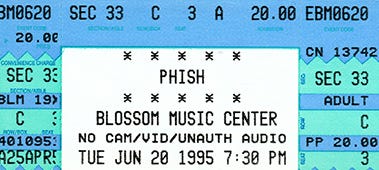
Yesterday, I focused on how viewing video footage changes the perception of a show. Today’s show offers a similar, if more subtle, fresh angle: the first opportunity to hear a full Summer 95 show in soundboard quality. The band’s first headlining gig at the lovely Blossom Music Center, where they sold “more than half of the 18,000 tickets,” was released direct to LivePhish in April 2013, joining 6/26 in Saratoga Springs as the only shows from this tour with official distribution at press time.
But before I indulge in audio straight from the source of Paul Languedoc’s mixing board, I should first note that the AUDs from this tour have been absolutely tremendous. Bigger venues don’t typically play nice with the taper section, but there really hasn’t been a dud in the bunch so far (using the sources on phish.in/ReListen) that had me longing for a SBD. I’m actually kind of curious why that is, as later tapes from these very same venues can be much tougher listens. Was Phish just in the sweet spot of their rising popularity: big enough for the best tapers to turn up, but not so big that they had to elbow aside inferior practitioners?
So no slight intended to the tapers, but there remain elements of the band’s sound that can be heard much more clearly in SBD format. At a time where Phish is gradually increasing their textural depth and democracy, it’s enlightening to hear the elements driving those changes, without the filter of questionable amphitheater acoustics.
Seven-Trey Salad
Trey’s noisier approach to playing guitar has been a recurring theme of these essays since the summer of 1994. You can easily appreciate this evolution on AUDs, but SBDs are especially illuminating about just what he was trying to achieve, and 1995 catches him poised right on the border between Old Trey and New Trey. On the opening Llama, Trey cycles through a number of different raunchy effects in his solo, but three songs later he returns with no issue to his classic, jazzy-clean tone for Foam.
Later in the show, the SBD offers high-resolution evidence of Trey’s newest trick: layers. Besides the more obvious Digital Delay Loop Jams that occasionally pop up, Trey is starting to understand how his loop pedal can provide additional textures in full-band improv. At a couple points in Melt, he triggers a pre-set loop that sounds like a jet engine revving up and back down, very similar to the drone he controls with his feet during Free mini-kit breaks. At 5:45 of Chalk Dust, he lays down a piercing loop and solos beneath it for a few seconds, the wild ancestor to future Ghost bweooos and Heavy Things chirps.
But it’s one particular stretch of Mike’s Song where Trey’s soundscape visions come briefly into focus. As soon as the second jam kicks off at 5:15, Trey deploys his full bag of tricks: the jet engine again, choked guitar screams that cycle from channel to channel, alien spaceship transmissions, piled on top of one another to create a wall of harsh psych noise. Then again from 16:00 through the drop into Contact, he’s at his most Frippian, layering effects and loops in an approach he’d obsessively pursue for the rest of the decade. It’s not quite the revelation of 1999 and 2000 boards, when Trey’s Kevin Shields worship is in full swing, but it’s still an early step in that direction that an AUD might blur.
Mike Steering Jams
In the years before People for a Louder Mike, the AUDs typically reproduce the diminished place of Mike’s bass in the room mix. But official releases of the 21st century generally correct for that slight, as much as they can when working with Paul’s on-the-fly recording (described here as “a soundboard/audience mix” and mastered by the wizard Fred Kevorkian). Hearing Mike on equal footing always boosts my appreciation for his ability to instantaneously counterpoint whatever direction Trey takes, which I realize is not a recent development in the mid-nineties, just one that’s typically hard to pick out from soupier sound. Check out his nimble work on the Chalk Dust jam — one of the most out-of-the-box versions to date — for just one example of his impossibly elastic reflexes.
But a more prominent Mike does offer some glimpses at when he steps up to steer a jam. Back on 6/14, I noted a place in the Mud Island Tweezer where he uncharacteristically assumed a leadership role, gently guiding the jam from a noisy climax into patient ambient beauty. The SBD here suggests those moments were already more frequent than I gave him credit for, even if his input mostly takes the form of nudges instead of Trey’s more noticeable yanks.
Or at least throwing them off balance in provocative ways. In one example, he tries to take the first-set Bathtub Gin into a different stratosphere around the 7th minute with a series of very insistent high notes, a segment that Trey follows up with a brief descending riff that reprises the hints of Mind Left Body jam from the previous show’s Bowie. Someone (Fish?) says “Mike, you’re it” after the jam abruptly ends — an acknowledgement that the strangeness of the song’s last few minutes was his to claim? It’s also essential to mention Mike’s lead bass in the 12th minute of his namesake song, a rare non-YEM spotlight for which he brings his own heavy effects.
Page’s New Toys (Or Not)
I so very much wanted to use this opportunity to talk about the new additions to Page’s rig on this tour — the Hohner E7 clavinet* and his first synthesizer — that will become very important to the band’s sound over time. Based on the video evidence from 6/19, I thought there would be more usage, but the SBD only reveals that The Chairman is still incredibly stingy with their use, predominantly sticking with piano and organ as his weapons of choice in nearly every jam. There’s some bloopy clavinet in the Melt jam for about 15 seconds, and it returns for several minutes of the Mike’s second jam, trying to keep up with Trey’s sonic adventurism. The synth, meanwhile, is completely absent; it’s usage on this tour seems limited primarily to Ha Ha Ha and Frankenstein thus far, neither of which show up on this night.

Of course, Page still has plenty to contribute with his more traditional keyboards. His grand piano acts as a tether in the deepest improv of Melt and Mike’s, a calm force that pulls the band back from Trey’s sound collaging. Still, there is perhaps a sense that his loyalty to the piano and organ hold Phish back in their textural pursuits, particularly on the evidence that at least two big stylistic leaps (1997 and 2017) were propelled by increased usage of clavinet and synthesizer, respectively. Perhaps a future SBD will catch a moment where they play a more prominent role.
Good Ol’ Solid Fishman
And then there’s Fishman, who the SBD “favors” with crystal-clear reproductions of his robust vacuum and pitiful cymbals during his two (!) featured solos in his show (it’s also a Double Nancy, for those keeping track of setlist oddities). But oh yeah, also his drumming. As always, I disclaim that my ear is poorly trained for understanding drums, beyond the observation that Fishman is perpetually, as the scholars say, killin’ it.
One thing I’ve noticed in the AUDs of this tour is a bit more emphasis on Fishman’s snare, whether by his choice or simply from shed acoustics. If it’s the former, it could be a symptom of Phish’s gradual adaptation to arena rock — a more direct, heavy approach to rhythm in big rooms. But the SBD pushes back on the idea that there’s any dramatic simplification going on behind the drum kit. Take the Melt jam, where he keeps the slippery, often-implicit beat, playing jazz complexity and variation at stadium intensity, dropping Keith Moon fills without ever sacrificing control.
Where the AUDs allow us to track the band’s collective transition to arena rock, the SBD provides some added clarity into how each individual band member is tackling that challenge. The easy solution would be to just get louder and simpler, but Phish’s artistic instinct is to combine that with deeper textures, a much more difficult task. It’s fair to say that each one is at a different stage in that process, which could contribute to some of the inconsistent moments of this tour. The view from the tapers section may be a confident, mature sound, but a closer look reveals the deliberate progress towards the next stage underneath.
[Thanks @mattdtabaka and @ry_storm for the quick clavinet knowledge/correction!]


